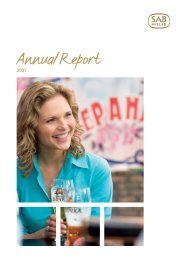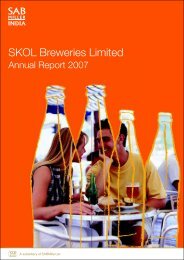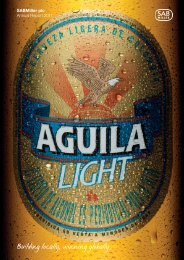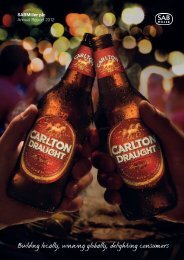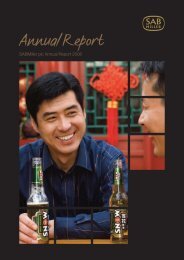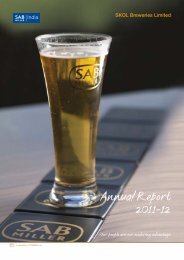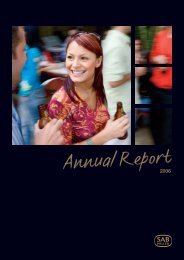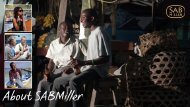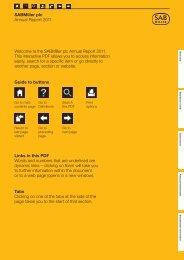Annual Report - SABMiller
Annual Report - SABMiller
Annual Report - SABMiller
- No tags were found...
You also want an ePaper? Increase the reach of your titles
YUMPU automatically turns print PDFs into web optimized ePapers that Google loves.
78 Notes to the consolidated financial statements <strong>SABMiller</strong> plc <strong>Annual</strong> <strong>Report</strong> 2010Notes to the consolidated financial statements continued1. Accounting policies continuediii) GoodwillGoodwill arising on consolidation represents the excess of the costs ofacquisition over the group’s interest in the fair value of the identifiableassets (including intangibles), liabilities and contingent liabilities of theacquired entity at the date of acquisition. Where the fair value of thegroup’s share of identifiable net assets acquired exceeds the fair valueof the consideration, the difference is recorded as negative goodwill.Negative goodwill arising on an acquisition is recognised immediatelyin the income statement.Goodwill is stated at cost less impairment losses and is reviewed forimpairment on an annual basis. Any impairment identified is recognisedimmediately in the income statement and is not reversed.The carrying amount of goodwill in respect of associates and jointventures is included in the carrying value of the investment in theassociate or joint venture.Where a business combination occurs in several stages, the goodwillassociated with each stage is calculated using fair value informationat the date of each additional share purchase.h) Intangible assetsIntangible assets are stated at cost less accumulated amortisationon a straight-line basis (if applicable) and impairment losses. Cost isusually determined as the amount paid by the group, unless the assethas been acquired as part of a business combination. Amortisationis included within net operating expenses in the income statement.Internally generated intangibles are not recognised except for softwareand applied development costs referred to under software and researchand development below.Intangible assets with finite lives are amortised over their estimateduseful economic lives, and only tested for impairment where there is atriggering event. The group regularly reviews all of its amortisation ratesand residual values to take account of any changes in circumstances.The directors’ assessment of the useful life of intangible assets is basedon the nature of the asset acquired, the durability of the products towhich the asset attaches and the expected future impact of competitionon the business.Intangible assets acquired as part of a business combination arerecognised separately when they are identifiable, it is probable thateconomic benefits will flow to the group and the fair value can bemeasured reliably.(i) Brands recognised as part of a business combinationBrands are recognised as an intangible asset where the brand hasa long-term value. Acquired brands are only recognised where titleis clear or the brand could be sold separately from the rest of thebusiness and the earnings attributable to it are separately identifiable.The group typically arrives at the cost of such brands on a relief fromroyalty basis.Acquired brands are amortised. In respect of brands currently heldthe amortisation period is 10 to 40 years, being the period for whichthe group has exclusive rights to those brands.(ii) Contract brewing and other licences recognised as partof a business combinationContractual arrangements for contract brewing and competitor licensingarrangements are recognised as an intangible asset at a fair valuerepresenting the remaining contractual period with an assumptionabout the expectation that such a contract will be renewed, togetherwith a valuation of this extension. Contractual arrangements andrelationships with customers and distributors are also valued on asimilar basis.Acquired licences or contracts are amortised. In respect of licences orcontracts currently held, the amortisation period is the period for whichthe group has exclusive rights to these assets or income streams.(iii) Customer lists and distributor relationships recognisedas part of a business combinationThe fair value of businesses acquired may include customer listsand distributor relationships. These are recognised as intangibleassets and are calculated by discounting the future revenue streamattributable to these lists or relationships.Acquired customer lists or distributor relationships are amortised.In respect of contracts currently held, the amortisation period isthe period for which the group has the benefit of these assets.(iv) SoftwareWhere computer software is not an integral part of a related itemof property, plant and equipment, the software is capitalised as anintangible asset.Acquired computer software licences are capitalised on the basisof the costs incurred to acquire and bring them to use. Direct costsassociated with the production of identifiable and unique internallygenerated software products controlled by the group that will probablygenerate economic benefits exceeding costs beyond one year arecapitalised. Direct costs include software development employmentcosts (including those of contractors used), capitalised interest andan appropriate portion of overheads. Capitalised computer software,licence and development costs are amortised over their useful economiclives of between three and eight years.Internally generated costs associated with maintaining computersoftware programmes are expensed as incurred.(v) Research and developmentResearch and general development expenditure is written off inthe period in which it is incurred.Certain applied development costs are only capitalised as internallygenerated intangible assets where there is a clearly defined project,separately identifiable expenditure, an outcome assessed withreasonable certainty (in terms of feasibility and commerciality),expected revenues exceed expected costs and the group has theresources to complete the task. Such assets are amortised on astraight-line basis over their useful lives once the project is complete.i) Property, plant and equipmentProperty, plant and equipment are stated at cost net of accumulateddepreciation and any impairment losses.Cost includes expenditure that is directly attributable to the acquisitionof the assets. Subsequent costs are included in the asset’s carryingvalue or recognised as a separate asset as appropriate, only when itis probable that future economic benefits associated with the specificasset will flow to the group and the cost can be measured reliably.Repairs and maintenance costs are charged to the income statementduring the financial period in which they are incurred.(i) Assets in the course of constructionAssets in the course of construction are carried at cost less anyimpairment loss. Cost includes professional fees and for qualifyingassets certain borrowing costs as determined below. When theseassets are ready for their intended use, they are transferred into theappropriate category. At this point, depreciation commences on thesame basis as on other property, plant and equipment.



